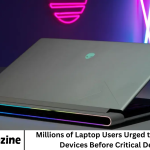Apple is preparing for another big week, but this time, there will be no flashy event, no dramatic keynote, and no long livestream filled with applause. Instead, the company is taking a quiet approach to unveiling its latest generation of powerful devices — the M5 iPad Pro, M5 MacBook Pro, and Vision Pro 2 headset.
- Apple’s Quiet Strategy
- The M5 Chip: Apple’s Next Leap in Performance
- The New M5 iPad Pro
- The M5 MacBook Pro
- Vision Pro 2: Apple’s Next Step in Spatial Computing
- Why Apple Is Skipping a Big Event
- What the M5 Generation Means for Apple’s Future
- Pricing and Release Details
- Should You Upgrade?
- The Future of Apple Devices
- Frequently Asked Question
- Conclusion
This soft launch shows Apple’s confidence in its hardware and signals a new direction — focusing on subtle improvements, faster chips, and smarter performance rather than dramatic redesigns. While the world expected another major event.
Instead of the usual stage lights, crowds, and cinematic product videos, Apple is taking a quieter path. This week, the company is preparing to quietly unveil its next generation of devices — the M5 iPad Pro, M5 MacBook Pro, and Vision Pro 2 — all powered by its most advanced chip.
More Read: Millions of Laptop Users Urged to Check Their Devices Before Critical Deadline
Apple’s Quiet Strategy
Apple has been known for its grand events — moments when the world stops to see what’s next. But recently, the company has been moving toward quieter, simpler product reveals.
Instead of inviting hundreds of journalists and streaming globally, Apple often drops press releases, videos, and new product listings on its website. It’s a softer, calmer way to share big news — and it fits perfectly for devices that improve performance rather than completely change design.
This week’s rollout will likely follow that same pattern: no stage lights, no special effects, just the quiet appearance of three new products — all powered by the next-generation M5 chip.
The M5 Chip: Apple’s Next Leap in Performance
At the heart of this update is the Apple M5 chip, the latest member of the company’s in-house silicon family. Since 2020, Apple has moved away from Intel chips to its own processors, bringing major boosts in speed, battery life, and efficiency.
The M5 continues that tradition but takes it even further. Built using advanced 3-nanometer technology, the chip delivers:
- Faster performance: Apple claims up to 20–30% faster CPU speeds compared to M4.
- Improved GPU: Ideal for graphic designers, 3D artists, and gamers who need high-end rendering.
- Better AI and machine learning: Thanks to an upgraded Neural Engine, the M5 can handle complex AI tasks directly on the device — such as image generation, real-time editing, and smart search.
- Enhanced battery life: More power but still energy efficient, meaning longer hours of use.
In short, the M5 isn’t just about speed — it’s about making every task smarter, faster, and more efficient.
The New M5 iPad Pro
The iPad Pro has always been Apple’s most powerful tablet, and the M5 version takes that to another level.
The design will look very similar to the current model, keeping its sleek, minimal look. But under the surface, the M5 chip changes everything.
Expected highlights include:
- Brighter OLED display for stunning visuals and accurate color.
- Improved Apple Pencil support, possibly with new gesture controls and pressure sensitivity.
- Faster multitasking, allowing users to switch between creative apps, documents, and editing tools without lag.
- Better AI tools in iPadOS, powered directly by the M5 chip.
For artists, video editors, and professionals, the new iPad Pro could be a dream device. It’s lightweight yet powerful enough to handle video editing, digital drawing, and AI-driven creative tools.
And while the outside might not look different, the inside will make a noticeable difference to anyone who depends on performance.
The M5 MacBook Pro
Apple’s MacBook Pro line has long been the standard for performance laptops. Now, with the M5 version, the bar rises again.
The new M5 MacBook Pro will come in the 14-inch and 16-inch sizes, both featuring brighter displays, quieter fans, and even faster performance.
Key improvements expected:
- Massive GPU boost for creative software like Final Cut Pro, Blender, and Adobe Photoshop.
- Extended battery life of up to 22 hours, thanks to the M5’s efficiency.
- Better thermal control, meaning it stays cooler during heavy use.
- Smarter AI integration, with macOS features optimized for M5.
The 14-inch version will appeal to travelers and professionals who need portable power, while the 16-inch model is designed for heavy workloads such as music production or 3D rendering.
Vision Pro 2: Apple’s Next Step in Spatial Computing
Apple’s Vision Pro headset was one of its most ambitious projects — blending virtual and augmented reality into what Apple calls “spatial computing.”
Now, with Vision Pro 2, Apple is improving performance and comfort. The M5 chip allows smoother visuals, faster response times, and more advanced AI-based interactions.
Expected upgrades include:
- Lighter design, making it more comfortable for longer wear.
- Improved display resolution for sharper visuals.
- Enhanced eye and hand tracking, powered by the new neural cores in M5.
- Better app performance, especially for 3D design, immersive video, and virtual collaboration.
With these upgrades, Vision Pro 2 could finally push spatial computing toward mainstream use, especially for creative professionals and developers.
Why Apple Is Skipping a Big Event
Apple doesn’t always need to make noise to make headlines. By launching these devices quietly, the company can:
- Control attention – Avoid overlapping announcements and let reviewers focus on product performance.
- Save costs and time – No need for large live events when most information can be shared online.
- Surprise the market – A sudden launch creates buzz without leaks spoiling the details.
- Let the products speak – The new M5 hardware is powerful enough to stand on its own.
This also shows Apple’s maturity. The company no longer needs to prove that it can innovate — it simply continues to refine and perfect what already works.
What the M5 Generation Means for Apple’s Future
Apple is clearly moving toward a new kind of computing — one where AI, performance, and local processing are deeply integrated. The company wants users to do more on-device rather than relying on the cloud.
That means faster AI tools in apps, smarter voice commands through Siri, and even creative tools that can generate or edit content instantly — all happening on the iPad or MacBook itself.
This also ties into Apple’s long-term privacy vision. By keeping more AI work on the device, users get faster results without sending personal data to external servers. In the next few years, Apple is likely to continue this path, making each new M-series chip even more focused on AI and GPU power.
Pricing and Release Details
Apple hasn’t officially hosted a big reveal event, but the pricing structure is expected to stay close to current models.
Estimated prices:
- M5 iPad Pro: Starting at around $999 (11-inch) and $1,199 (13-inch).
- M5 MacBook Pro: Starting near $1,999 for 14-inch and $2,499 for 16-inch.
- Vision Pro 2: Likely around $3,499 or slightly higher depending on configuration.
All devices are expected to become available for order this week, with deliveries beginning soon after.
Should You Upgrade?
Whether you should upgrade depends on how you use your device.
You should upgrade if:
- You use your iPad or MacBook for professional creative work, video editing, or coding.
- You want access to Apple’s newest AI features and faster local processing.
- You plan to use Vision Pro 2 for development or professional 3D work.
You can skip for now if:
- Your current device runs smoothly and you don’t need the latest AI performance.
- You mostly use your iPad or MacBook for basic tasks like browsing, writing, or streaming.
The M5 devices are designed for those who need more speed and smarter tools, but everyday users will still be fine with M4 or even M3 models.
The Future of Apple Devices
The M5 lineup is another sign that Apple’s focus is shifting. Instead of creating brand-new products every year, it’s building a stable foundation of devices that share one powerful core — its custom silicon.
By improving its chips, Apple makes everything faster, smarter, and more unified. Each device — from iPhone to MacBook to Vision Pro — can now communicate better and perform complex tasks seamlessly.
As AI becomes central to computing, Apple is clearly preparing for that future — quietly but confidently.
Frequently Asked Question
What is Apple launching this week?
Apple is quietly introducing three products — the M5 iPad Pro, M5 MacBook Pro, and Vision Pro 2 headset. All three feature the new M5 chip for faster performance and smarter AI capabilities.
Why is Apple not holding a big event?
Because these are mostly performance-focused updates, Apple decided to skip a big keynote and release them quietly. It allows more focus on real-world performance rather than stage presentations.
What’s special about the M5 chip?
The M5 chip is faster, more power-efficient, and built for AI. It improves graphics, processing speed, and battery life while enabling advanced on-device AI features.
Will the design of the iPad Pro and MacBook Pro change?
No major design changes are expected. The focus is on improved internals and performance rather than new shapes or materials.
Is the Vision Pro 2 worth upgrading to?
Yes, especially if you work in 3D design, virtual collaboration, or app development. It’s faster, lighter, and more responsive thanks to the M5 chip.
How much will these devices cost?
Prices are expected to be similar to previous models: around $999 for the iPad Pro, $1,999 for the MacBook Pro, and about $3,499 for the Vision Pro 2.
Should I upgrade to M5 from M4?
If your work depends on graphics, AI, or pro-level tasks, the M5 will be a clear improvement. If you use your device for regular tasks, you can wait — the M4 is still powerful.
Conclusion
Apple’s quiet release of the M5 iPad Pro, MacBook Pro, and Vision Pro 2 shows that big innovation doesn’t always need a stage. The new M5 chip delivers major boosts in speed, efficiency, and AI power — marking another step in Apple’s journey toward smarter, faster computing.
Apple may be unveiling its biggest performance leap of the year without the usual fanfare. But make no mistake — the M5 iPad Pro, MacBook Pro, and Vision Pro 2 represent major steps forward in Apple’s journey toward smarter, faster, and more efficient technology.









